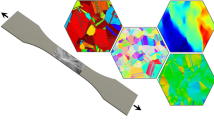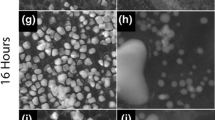Abstract
A linear relationship between mobile dislocation density and creep strain has generally been assumed in various models of creep in Ni-base superalloys. No stress or temperature dependence is assumed in such relationships. The current study aims to verify this relationship by use of an X-ray rocking curve-based method on DS GTD111™, a directionally solidified (DS) nickel-base turbine blade alloy. A new measurement scheme tailored for such large-grained, DS alloys using simultaneous tilt–twist methodology is outlined. Multiple test sets of DS GTD111™, creep tested under varying boundary conditions, were measured using this technique. The resulting rocking curve full-width-half-maxima (square root of the dislocation density) were found to correlate to creep strain by a simple linear transfer function with no systematic dependence on stress or temperature. As a validation case, application of this transfer function is demonstrated for long-term test data.











Similar content being viewed by others
References
B.F. Dyson and M. McLean: Acta Met., 1983, vol. 31, pp. 17-27.
B. F. Dyson: Mat. Sci. Tech., 2009, vol. 25, 213-220.
Z. Zhu, H. Basoalto, N. Warnken and R. C. Reed: Acta Mat., 2012, vol. 60, pp. 4888-4900.
A. Manonukul, F.P.E. Dunne and D. Knowles: Acta Met., 2002, vol. 50, pp. 2917-2931.
T. Ungar: Pow. Diff., 2008, vol. 23, pp. 125-132.
A. Borbely and T. Ungar: Comp. Rend. Phys., 2012, vol. 13, pp. 293-306.
G. Zilahi, T. Ungar and G. Tichy: J. Appl. Cryst., 2015, vol. 48, pp. 418-430.
B. E. Warren: X-ray Diffraction, 1969.
G. K. Williamson and W. H. Hall: Acta Metall., 1953, vol.1, pp. 22-31.
P. Krivoglaz: Theory of X-ray and Thermal Neutron Scattering by real Crystals, 1969.
M. Wilkens: in Fundamental Aspects of Dislocation Theory, NBS Special Publication No. 317 II, J.A. Simmons, R. de Wit, and R. Bullough, eds., US Department of Commerce, 1970a, pp. 1195–1221.
M. Wilkens: Phys. Status Solidi. A, 1970b, vol. 2, pp. 359-370.
T. Ungar and A. Borbely: Appl. Phys. Lett., 1996, vol. 69, pp. 3173-3175.
T. Ungar, I. Dragomir, A. Revesz and A. Borbely: J. Appl. Cryst., 1999, vol. 32, pp. 992-1002.
T. Ungar, J. Gubicza, G. Ribarik, and A. Borbely: J. Appl. Cryst., 2001, vol. 34, pp. 298-310.
I. Groma: Phys. Rev B, 1998, vol. 57, pp. 7535-7542.
N. S. Husseini, D. P. Kumah, J. Z. Yi, C. J. Torbet, D. A. Arms, E. M. Dufresne, T. M. Pollock, J. W. Jones and R. Clarke: Acta Mat., 2008, vol. 56, pp. 4715-4723.
B. D. Cullity and S. R. Stock: Elements of X-ray diffraction.
L. V. Azaroff: Progress in Solid State Chemistry, 1964, vol.1, pp. 347-379.
A. D. Kurtz, S. A. Kulin and B. L. Averbach: Phys. Rev., 1956, vol. 101(4), pp. 1285-1291.
K. J. Bachmann, T. O. Baldwin and F. W. Young Jr.: J. App. Phys., 1970, vol. 41(12), pp. 4783-4789.
M. J. Hordon and B. L. Averbach: Acta Met., 1961, vol. 9, pp. 237-246.
K. Igashira: The Japan Soc. of Mech. Eng., 2008, vol. 74(739), pp. 308-314.
J.W. Aveson, G. Reinhart, H. Nguyen-Thi, N. Mangelinck-Noel, N. D’Souza, and H.J. Stone: Eurosuperalloys, 2014, MATEC Web Conf., vol. 14, 05003, pp. 1–5.
R. Oruganti, A. Shukla, S. Nalawade, K.G.V. Siva Kumar, T. Vishwanath, S. Sarkar, S. Sondhi, A. Wessman, D. Wei, A. Powell, K. Bain, J. Schaeffer, A. Peck, M. Arnett, G. Shastry, and F. Mastromatteo: ASME J. Eng. Mater. Technol., 2018, vol. 141, pp. 011001-1-5.
Online document: Sampling from finite populations, http://wps.prenhall.com/wps/media/objects/9431/9657451/Ch_07/levine-smume6_topic_07-06.pdf, accessed 24th Nov 2017.
Acknowledgments
Funding from the Services-AT, GE Global Research managed by Russell Irving and Vinod Kumar is gratefully acknowledged. Mallikarjun Karadge (GE Global Research, Niskayuna) and Stefan Haaga (Bruker) are thanked for their invaluable guidance during this reserch. B. K. Prasanna is thanked for performing the meticulous metallography work. The authors gratefully acknowledge the transmission electron microscopy work done by Amuthan Ramar.
Author information
Authors and Affiliations
Corresponding author
Additional information
Manuscript submitted November 24, 2017.
Appendix
Appendix
1.1 Calculation of Error Bars of FWHM
The standard error at 95 pct confidence associated with a sample of size n and standard deviation s, chosen from a finite-sized population N is given by[26]:
To calculate the standard error of each datapoint in Figure 8 that corresponds to rocking curve measurements sampled from grains of a specific creep test bar, we proceed as follows. In this scenario, n and N refer to the number of grains sampled by the XRD measurement and the total number of grains in the test bar, respectively. Considering cylindrical test bars of 6.25 mm gage diameter Do and average diameter of columnar grains do to be 2 mm, the total number of grains N comprising the cross section of the bar is given by \( N = \frac{{\pi D_{\text{o}}^{2} }}{{\pi d_{\text{o}}^{2} }} \sim 10. \) On average, the number of grains spanning a longitudinal section, cut along a diameter of the test bar is \( n^{\prime} = \frac{{D_{\text{o}} }}{{d_{\text{o}} }}\sim 3. \) Let us assume further that these n′ grains have orientations that are normally distributed about the ideal [001] direction within ± 15 deg. Now, the coarse RC-ψ scan spans ± 7.5 deg in ω, exactly half of the ± 15 deg range of allowed excursion. Therefore, the actual number of grains n that will be picked up by the measurement is n′ multiplied by the probability of grain orientations lying in the ± 7.5 deg range. This probability can be worked out to be 0.95 for a two-tailed normal distribution by assuming that the probability of finding grain orientations beyond the extremities, viz., + 15 or − 15 deg is very small; i.e., P(X > 15 deg) = P(X < −15 deg) = 0.0001. This calculation yields n to be equal to 3. Accordingly, the fractional coverage \( \frac{n}{N} \) is \( \frac{3}{10}, \) which was used in the calculation of standard error using the formula listed above.
Rights and permissions
About this article
Cite this article
Siva Kumar, K.G.V., Oruganti, R. & Chatterjee, P. X-Ray Rocking Curve Measurements of Dislocation Density and Creep Strain Evolution in Gamma Prime-Strengthened Ni-Base Superalloys. Metall Mater Trans A 50, 191–198 (2019). https://doi.org/10.1007/s11661-018-4971-y
Received:
Published:
Issue Date:
DOI: https://doi.org/10.1007/s11661-018-4971-y




